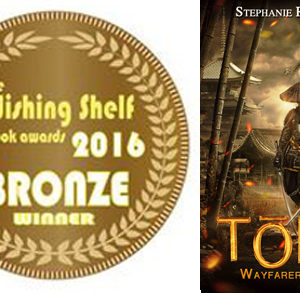 One of our first stops on the tour is Lampshade Reader.
One of our first stops on the tour is Lampshade Reader.
Please find our full guest post here, including our essay on the background and sources–Steampunk, Japan and history–for “Toru: Wayfarer Returns” and an excerpt featuring impertinent Jiro, future dirigible pilot. Highlights from the essay include my admiration for Cherie Priest’s innovative blend of zombies and the Civil War and why I considered but decided against including shapeshifters in my own work. I also talk a bit about the history and context for the events that unfold in “Toru: Wayfarer Returns.” And I show off my own airship, a much more modern model than the primitive experimental prototypes flown by Toru and Jiro.
And because I never tire of posting this picture, enjoy!
Here’s the full Guest Post and Excerpt for your convenience.
Background of the book.
Alternate History and Finding Hinge Moments
“Tōru: Wayfarer Returns” evolved from several passions of mine: steampunk, history and Japan.
I live in a Victorian mining town where everyone dresses up in Victorian dress for local festivals, which led me to stumble across the Steampunk and Maker movements after searching online for dresses. (Here is one I made, with my airship as background.)

After plowing through a massive pile of steampunk novels, I wanted to write one of my own.
I very much admired how Cherie Priest had created a vaguely Civil War period to use as a backdrop for steampunk adventures in her Clockwork Century series. While taking massive liberties with history, she used location brilliantly to add atmosphere and depth to her stories, as in her settings in New Orleans and Seattle. I cracked up reading one of her Author Notes where she described outraged readers complaining that she used in her story buildings built twenty years after her time period and she’s like, “And you’re willing to overlook the zombie apocalypse?!?” Fiction, people, fiction! Anyway, I found her series very inspirational, from her characters to her use of atmosphere and the fun mixing of the fantastical with the adventurous with the zombie apocalypse and derring-do in dirigibles.
While noodling on her example, I realized that Victorian England and the American Wild West had been done to death in the steampunk books I had read. I needed a fresh geography, which led me to my core idea: Aha! A steampunkish alternate history! In Japan!
The Japan angle lit me up, for it connected deeply with a special time in my life. As a sixteen-year-old, I had gone to Japan as an exchange student. (Thank you, Rotary Club!) For a year I attended a Japanese high school and lived with several wonderful Japanese families. I went on to major in Economics and Asian studies, with minors in Japanese and physics, and returned to work in Japan for several years just out of school. I fell in love with Japan’s unique and profoundly different culture during those years. Where the rest of the world zigs, Japan zags. They do things their own way and I admire that.
So I had a genre (steampunk/alternate history), a setting (Japan). Now I needed a story. Enter my third love, for history. I dug into “steampunk era” Japanese history of the nineteenth century looking for a good “hinge moment” for my alternate history, the moment where, if things had gone differently, history might have changed dramatically. Imagine the world, for example, if the Nazis had fought off the Allied Normandy invasion, or the Anglo-Saxons had repelled the Norman invasion of England, or the South had won the Civil War. I quickly found the perfect moment—the arrival of the American Commodore Perry in Japan in 1853.
If you will permit me a brief historical note, Japan had been in self-imposed isolation for 250 years under the rule of the Tokugawa Shoguns when the Americans showed up in 1853. Fearing the influence of Western religion and weapons, the Tokugawa Shoguns had forbidden all contact with the outside world, and condemned to death anyone who traveled abroad and then returned to Japan. When Perry appeared off Japan’s coast, he found an agrarian, largely feudal society. Facing steamships and repeating rifles, the Japanese were powerless to resist and were forced to open to the despised barbarians, first the Americans and then the British, the Dutch and the Russians. This was a profoundly destabilizing event for the Japanese, and led, by 1868, to the overthrow of the Tokugawa regime and its replacement by a different set of elite lords in the name of the Emperor bent on modernizing Japan. The historian in me is fascinated by this 1853 to 1868 period, when Japan went through such far-reaching change. It was as major a transformation as that wrought by the French Revolution, or the American Revolution, or the American Civil War. To circle back to Cherie Priest, I decided this period would be the backdrop for my series, like the Civil War was for her series.
I also noted that Cherie Priest included a zombie apocalypse in her series. Very nice. Now, Japan doesn’t do much with zombies, but they have a rich and wonderful folklore about shapeshifters, so my original concept was to blend Japanese shapeshifters as a fantasy element in with the alternate history bits like she included her zombie armies. Once I began developing the story though, I was forced to let the shapeshifters go. They just didn’t fit into the steam-and-dirigible world I was building, and so with great regret I set them aside. I love that material though, and have notes for a “Sakura Shapeshifter” series.
During my dig through “steampunk era” Japanese history, I found additional inspiration in the story of Manjiro, a shipwrecked ship’s cook rescued by traders and taken to America in the 1840s. He eventually came back to Japan, and rather than being executed was taken to the Shogun and asked to tell the government about the Americans. They made him a samurai, and he helped somewhat with that meeting with Perry. He was not educated, though, and unable to guide the resistance effort. So my “what if” became “What if Japan had possessed the will and the technology to fight off Commodore Perry?” through the means of “What if an educated and astute person had deliberately brought that technology back to Japan to save his country in time to meet the foreign threat?” Also in the history books I found the perfect father for my hero, but I’ll leave that to readers to discover.
The story I created is true to the period, the time, the culture and the history up to that moment, and mixes both fictional and historical characters in the plot, while using the magic of steampunk technology, dirigibles and passionate leadership to change the course of history.

“Rather than argue with them, you should invite them to make the first flight with you,” said Takamori. “At first they will agree, since it is their place as the leaders. Everyone is very excited about the dirigibles. Set the time and place for the first flight. Jiro should explain that is not a good time because of the wind or something technical that needs testing first. You argue with Jiro and perhaps even scold him for impertinence in front of the daimyōs.”
“Yes, I am often scolded for impertinence,” said Jiro. “I have a talent for it, you know.”
“Indeed you do,” said Tōru. He saw where Takamori was going. “Then they notice the risks and uncertainties…and they ask me if it is safe. I tell them honestly that we have no idea if it is safe or if it will work, and that we might all crash to a fiery death and therefore perhaps I should test it first myself before we endanger them.”
“And I will be impertinent again and tell you in front of them that you don’t have a clue how to fly one of these dirijibi!” Jiro finished the plan for them. “Which is also true, by the way. I know how to fly one of these, and you don’t.”
“You’ve never flown one either,” protested Tōru.
“I have built one. Almost. Soon. How many have you built?” asked Jiro, with his broad grin.
Tōru opened his mouth and closed it again.
“See? Problem solved,” said Takamori, as he pounded Tōru on the back. “We have a fine dirijibi pilot, the finest dirijibi pilot in all of Japan, our good man Jiro here.”






Recent Comments